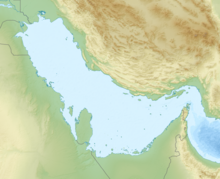2016 U.S.–Iran naval incident
| 2016 U.S.–Iran naval incident | |||||
|---|---|---|---|---|---|
|
|||||
| Belligerents | |||||
|
|
|
||||
| Commanders and leaders | |||||
|
|
|
||||
| Units involved | |||||
|
|||||
| Strength | |||||
| 10 servicemembers, 2 Riverine Command Boats | 4 small boats | ||||
| Casualties and losses | |||||
| 10 captured, 2 boats seized (all released) | None | ||||
|
|
|||||
On January 12, 2016 two United States Navy riverine command boats were seized by Iran's Islamic Revolutionary Guard Corps (IRGC) Navy after they entered Iranian territorial waters near Iran's Farsi Island in the Persian Gulf. Initially, the U.S. military claimed the sailors inadvertently entered Iranian waters due to mechanical failure, but it was later reported that they entered Iranian waters because of navigational errors. The U.S Secretary of State John Kerry called the Iranian Foreign Minister Mohammad Javad Zarif within five minutes. His call was followed by multiple other phone calls between the two ministers. The sailors had a brief verbal exchange with the Iranian military and were released, unharmed, 15 hours later.
The release was hailed by the Obama administration as an unintended benefit of the new diplomatic relationship with Iran established by the nuclear accord, while some US Republican presidential hopefuls such as Ted Cruz and Donald Trump criticised the US response to the detention, which they deemed too weak.
On January 12, 2016 two United States Navy riverine command boats cruising from Kuwait to Bahrain with a combined crew of nine men and one woman on board strayed into Iranian territorial waters which extend three nautical miles around Farsi Island in Persian Gulf. Patrol craft of Iran's Islamic Revolutionary Guard Corps (IRGC) Navy seized the craft and detained the crew at a military base on Farsi Island.
...
Wikipedia

